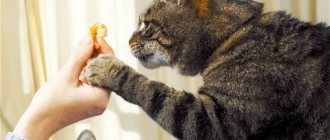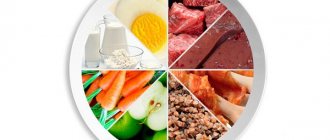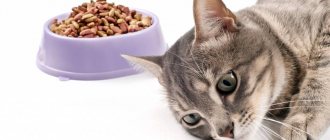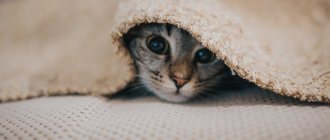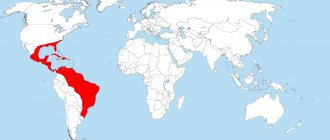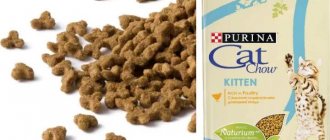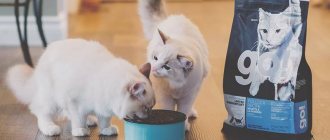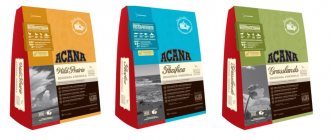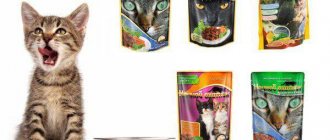You can talk for a long time about how to switch a cat to a natural cat. But in the end it all comes down to a few techniques. If the animal is not accustomed to eating meat, then it needs to be taught this. After all, the “factory settings” of the cat’s body are designed specifically for the consumption of meat, and not dry pads.
It is possible to train a cat to eat raw meat at any time and at any age. You need to remember this, because some animals try to prove the opposite with their behavior. As a result, the process drags on for months and ends with the owner’s capitulation.
Why is this happening? Because cats are cunning creatures. And domestic cats, as a rule, are also overfed. Therefore, they can afford to sort out grub and educate the owner.
So how do you train a cat to eat meat?
Mix meat into food
If you're up for a multi-week journey, gradual food switching may be an option for you. To do this, they begin to add a little raw meat to the usual food. Gradually, in portions, the amount of feed is reduced, and the amount of meat is increased. And so on until the moment when only meat remains on the plate.
Abrupt refusal of factory feed
The second path is suitable for those who are ready to overpower the cat’s character. The food is abruptly stopped and only meat is given. At first you can baked or boiled, because... it looks more like food.
The cat may react negatively to this turn of events and completely refuse to eat for several days. In this situation, it is important not to give up and not give the usual food, no matter how the animal begs. As a result, after a few days the cat gives up and begins to eat the food offered.
EXPERT COMMENT: veterinarian-felinologist Yulia Brovko
This method works in 90% of cases, but many are afraid of it because of the danger of developing liver lipidosis. This condition most often occurs in overweight cats that have been fasted for long periods of time. If your cat is young, healthy and not overweight, then fasting for up to 4 days will not cause lipidosis, but you will achieve the desired result.
During the game
The author’s cat, who had been eating cooked meat all her life, was taught to eat raw meat through play. During the game, they began to use not a mahalla, but a piece of meat. The cat had to hunt him. And since during the hunt, when a cat catches something, it instinctively takes it into its mouth and chews it, having caught the meat, it began to do the same with it. The meat turned out to be tasty (of course, it was quail!) - and since then the cat has only eaten raw.
Using baked meat
Another way to get your cat interested in meat is to boil or bake it, and then chop it finely so that the pieces become the size of drying pads. Then it looks more like food, and accordingly, the cat may be more willing to try such a product.
If the cat eats factory-made pates, then grind the meat in a meat grinder and make a pate. Pates and minced meats are not suitable for permanent nutrition, but for the transition period they can be a lifesaver.
Using an attractant
Natural attractants are also used as a trick. Many cats love the smell of fish. Therefore, the meat can be poured with canned fish juice.
Try different types of meat
Typically, cats do not like all types of meat equally. Therefore, if you tried only one type and the cat refused it, this does not mean that he will refuse the other. Experiment! Hint: most often cats love liver and heart.
What components does ready-made food include?
Any ready-made food, even the most expensive, includes carbohydrates, animal and vegetable protein, fats, flavorings and vitamins.
In economy class feed, the percentage of protein is no more than 6%.
In the premium class, protein reaches 50%.
As we see, a large percentage of any feed is carbohydrates, mainly corn or potatoes.
Disadvantages of dry food in cat nutrition
Industrial feeds are addictive because they contain a large number of additives. Popular brands do not contain essential microelements; their minimal amount does not cover the damage to the digestive system caused by other ingredients. Long-term consumption of dry food leads to diseases of the digestive and genitourinary systems, stomach, and kidneys.
Causes and consequences of an inadequate cat diet
- Reason: High carbohydrate content in the feed. Consequences: Colic, bloating, ulcers, constipation, kidney failure.
- Cause: Insufficient fluid intake. Consequences: Constipation, kidney stones, kidney disease.
- Reason: Flavorings and flavoring additives in food. Consequences: Increased blood sugar levels and diabetes.
To normalize the functioning of internal organs, you need to feed your cat natural food. A change in diet can be temporary or permanent, depending on the veterinarian’s recommendations and the animal’s well-being. The minimum period for alternating food is 3 months. Frequent changes or combined meals will lead to poor health and diarrhea.
Video on how to prepare natural food for a cat for a month
Soups, broths, milk are not food for predators who are used to gnawing and chewing. Cats living in villages eat small rodents, birds, fish, insects, and sometimes fresh grass.
Soups, broths, milk are not food for predators who are used to gnawing and chewing
This diet replenishes the cat’s body with essential nutrients.
The home diet should contain:
- Proteins (50%). This is raw lean meat and fish, cottage cheese, fermented milk products, as well as liver, stomachs, and heart. Meat and fish products should be frozen to prevent the animal from becoming infected with parasites.
- Fats (35%). They are found in meat, and sources of vegetable fats can be wheat and corn.
- Carbohydrates (10%). Porridge, vegetables, fruits.
- Food additives (5%). Bone meal, oils, vitamins. Sources of vitamins will be fresh fruits, legumes, and green grass. You can purchase vitamin complexes in veterinary pharmacies, but strictly as prescribed by a specialist. The addition of bifidobacteria will contribute to the restructuring of digestion.
Food in the form of minced meat is not suitable for cats - they swallow meat in pieces according to their size. This does not harm the animals - this is their physiology.
You can add a little chopped lettuce, broccoli, pumpkin, beets, zucchini, and carrots to the finely chopped meat. Taboos for cats are eggplants and tomatoes in any form. These vegetables can lead to food poisoning.
>How to feed a cat correctly: natural or dry food and how many times
Transfer to natural food
Natural food refers to raw foods that are available to a cat living in its natural environment.
Accustoming a cat to new food is not easy, but it is possible even with a long history of dry feeding.
Accustoming a cat to new food is not easy, but it is possible even with a long history of dry feeding
Due to the lack of a familiar smell, the cat may not initially understand that there is food in front of her. An animal that is carnivorous by nature will stubbornly refuse all natural delicacies and persistently demand familiar food.
Be sure to read:
How to feed a cat correctly: natural or dry food and how many times
The main condition for switching to a different diet is the complete absence of dry food in the apartment. A cat's sensitive sense of smell will detect its scent anywhere. Before weaning your cat off drying, you need to think through the diet and prepare food in advance.
The transition sometimes lasts more than a month. In difficult cases, the functioning of the digestive tract in animals is disrupted. The owner needs to act gently and not put pressure on the pet.
Transition process
We always start with one type of meat. This does not depend on whether the cat immediately switches to raw, or whether he is transferred in stages through baked and boiled. We introduce one type of meat once a week and watch the reaction. If there is no allergic reaction (it can manifest itself in the form of vomiting, scratching, hair loss, etc.), then the product is suitable. If a negative reaction is observed, we cancel the product and do not use it again.
New products can be introduced to kittens more often: once every 3-4 days, because their metabolic processes proceed better - and allergies, if any, will become noticeable earlier.
How to train a cat to eat everything?
Most owners find it more convenient and cheaper to feed their pets regular food than high-quality but unaffordable industrial food. Homemade food is better than dubious pelleted food. But the problem is that pets often organize a “boycott” when trying to switch them to “natural”. And the reason lies in monosodium glutamate, a substance that is part of food and causes addiction in cats. It's not easy to get rid of it. Therefore, you can teach a cat to eat everything, showing maximum patience and perseverance. This is why many veterinarians initially do not advise introducing cats to dry food. To teach your pet to eat everything, you will need at least two weeks. Experienced breeders emphasize that the transition should not be abrupt. And to alleviate it, the cat must first be accustomed to wet food for 3-4 days. It is recommended to mix dry food and add canned food to it. Then the dry portion must be replaced with meat and offal. This should also take at least 4-5 days. Over time, porridge, boiled eggs, and vegetables are mixed into the wet food. The portion of canned food should be reduced to the very minimum and so switch to regular food that is healthy for cats. At the final stage, it is recommended to use only the gravy from the feed. It is at this time that the greatest difficulties and the cat’s refusal to eat may arise. Be patient and persevere. Cats can go without food for a day or two without any harm to their health. So sometimes it’s useful to hide the food that your pet refused at breakfast until the evening. Under no circumstances should you replace it with something the cat likes, or offer something else after an hour. If you haven't eaten, you're not hungry! Not a single cat has ever died of hunger when there was a bowl of food nearby.
As for the most undemanding diet, you should understand that there are foods that cats simply do not eat under any circumstances. For example, by combining beans with offal, you will notice that the cat eats only the meat part of the dish. You can try to trick him and just chop the legumes next time.
Those foods that the cat doesn’t like can be mixed with his favorites - try it that way. Or give them in minimal quantities. But remember that cats are not omnivores, and they will not eat absolutely everything.
A sensitive topic that causes a storm of emotions and condemnation from “caring” owners is the transfer of an animal to a new diet. But the situation really heats up to the limit when it comes to cats and refusal of dry food, even to the point of statements: “My Barsik will die of hunger!” But about everything in order - how to accustom a cat to homemade food, what is the need for this and what you will have to go through, read below.
Advice from “cat people”
We have collected for you the experience of people who managed to switch their pets to natural food, maybe one of the methods will suit your cat:
“Divide the daily ration of prepared food into 10 parts. On the first day, we replace one part in the morning with natural. On the second day, we replace two parts with natural food and add more and more natural food until the cat completely switches to natural food.”
Pros and cons of natural nutrition
The main advantage of switching your cat to homemade food is that you know exactly what you are feeding your cat. The quality of food from the store is sometimes questionable, but here it is real food, prepared by the owner himself.
One of the disadvantages is that if the cat eats natural food, it can become infected with parasites. The problem can be solved by heat treatment of meat and prevention of worms in cats.
In addition, unlike food, you will have to spend time preparing food. And not only for cooking, but also for thinking through the diet.
The idea should be abandoned if you often leave and give the cat under the care of other people. Constantly changing food from natural to food and back will only harm the cat.
Also, do not switch your cat to natural food if you follow a vegetarian diet. Cats are predators, and they cannot live without meat, and it will be difficult for a vegetarian owner to cook meat.
Procedure for transferring a pet to dry feeding
Before switching your pet to dry food, you should pay special attention to its habits and behavior. If the owner notices that the cat consumes little water, then it is not advisable to switch it to dry feeding, since otherwise there is a high probability of disturbances in the functioning of the animal’s urinary system. With a small amount of water consumed, the animal makes up for its deficiency from wet food. If you still need to retrain your pet for dry feeding, then at the initial stage of feeding this type of food it should be soaked.
When transferring a cat to dry feeding, you should monitor the presence of the required amount of clean water in the cat's drinking bowl.
In order to understand how to switch your cat to dry food, you should familiarize yourself with the feeding dosages indicated on the packaging material for the food. In the first days, you should not pay special attention to these dosages.
For the first 2 days, dry food should be mixed in small quantities with the animal’s usual food. At the initial stage, it will be enough to add 10-15 crackers.
When mixing dry feed mixture, it should be soaked in the animal’s usual food. When transferring a cat to dry feeding, you should monitor the presence of the required amount of clean water in the cat's drinking bowl. The fact is that when feeding on dry food, an animal must consume 4 times more liquid than the food it eats. Otherwise, the animal may develop kidney disease, especially for males.
After switching your pet to dry feeding, you should not feed it food from the table.
In order to transfer a cat from natural and familiar food to dry food, you should gradually increase the proportion of dry food in the composition of the usual food every day. At the same time, the volume of usual natural food should be proportionally reduced. If the cat refuses to eat the food offered, it is recommended to change the manufacturer or add crackers without soaking.
By the tenth day of feeding, all foods should be completely eliminated from the cat’s food, leaving only dry food. After switching your pet to dry feeding, you should not feed it food from the table, and you should not give it the rest of your food. From the tenth day, the cat should eat only dry food.
It is recommended to feed the animal with food from only one manufacturer and only with food that is intended for feeding animals of a certain age. The dosage of food is calculated in accordance with the recommendations indicated on the packaging by the food manufacturer.
It is recommended to feed only one animal with food class=”aligncenter” width=”670″ height=”377″|fcw3qayjh5a| src=”https://animashka.info/wp-content/uploads/post_5c30445367307.jpg” class=”aligncenter” width=”670″ height=”377″|fcw3qayjh5a| src=”https://animashka.info/wp-content/uploads/247fa67d6d982dff06e10e2a58bde3413.jpg” class=”aligncenter” width=”670″ height=”386″|fcw3qayjh5a| src=”https://animashka.info/wp-content/uploads/563a191229ca859fdc35eb2b2e67ce5e3.jpg” class=”aligncenter” width=”670″ height=”390″|fcw3qayjh5a| src=”https://animashka.info/wp-content/uploads/7fe0c8902813114562ec0a091ee726123.jpg” class=”aligncenter” width=”670″ height=”435″|fcw3qayjh5a| src=”https://animashka.info/wp-content/uploads/post_5c3046bb26206.jpg” class=”aligncenter” width=”670″ height=”447″|fcw3qayjh5a| src=”https://animashka.info/wp-content/uploads/post_5c3055d31d6df.jpg” class=”aligncenter” width=”670″ height=”461″|fcw3qayjh5a| src=”https://animashka.info/wp-content/uploads/post_5c30451054cb02.jpg” class=”aligncenter” width=”670″ height=”488″|fcw3qayjh5a| src=”https://animashka.info/wp-content/uploads/post_5c3047d1eb686.jpg” class=”aligncenter” width=”670″ height=”501″[/img]
Ways to switch to natural food
When, for various reasons, the owner decides to wean a cat off harmful dry food, he needs to be patient. Some animals resist for a short time, others persist for a long time, leading their owners to despair.
But the natural survival instinct will definitely work - the cat will start eating. No animal voluntarily dies of starvation when there is a bowl of food nearby.
There are different ways to switch to a different diet. But in all cases it is based on natural meat.
Force method
Do not give in to pity and stop dispensing dry food completely . Offer easy-to-digest foods and offal, cut into pieces.
Do not give in to pity and stop dispensing dry food completely
Give food strictly on time; after a quarter of an hour, remove the bowl in any case so that the food does not turn sour. The animal will eventually understand that there will be no other food. Clean water should always be available.
A sudden switch to natural food often leads to hunger strikes and digestive problems. If the cat does not eat for a long time, then it is better to try another method.
Persuasion method
If, in addition to dry food, the cat has other treats, then you need to increase their quantity, reducing the portions of drying. In this way, you can wean the animal off artificial food, but at the same time accustom it to other food of little benefit.
Reduction method
You can try to gradually reduce the portion of artificial food. Having not eaten enough dry food, the cat will finish eating natural food from another bowl. Gradually, over the course of a week or two, he will get used to the new food.
Be sure to read:
When to start feeding kittens: how to introduce them, diet, what not to feed, age for first feeding
Mixing Method
This method takes a long time, but is the most gentle and effective. It is necessary to gradually reduce the share of artificial food day by day, adding natural food.
Add canned meat to drying, mix with meat and vegetables, increasing their quantity. Time will pass, and the animal will not even notice the absence of its usual food.
Such a smooth transition will take place without negative consequences for the animal’s digestive system. Adding catnip to your new diet will speed up the adjustment process.
Attention! With any method, it is important to give your pet vitamins to maintain the body. The veterinarian will give advice on their choice, taking into account the weight and age of the animal.
Reasons for changing your diet
The main reason is indisputable evidence that natural food is healthier than any prepared food.
You need to change your diet if the following symptoms appear:
- Frequent gastrointestinal problems: constipation, diarrhea, diarrhea.
- Constant belching and regurgitation, bloody salivation.
- Excessive hair loss and bald patches.
- Recommendations from a veterinarian in connection with the developmental characteristics of the animal, as well as after surgical operations.
- Improving the pet’s quality of life and improving its condition.
Irreparable harm to health from dry food
Such food can cause a lot of problems, the most common of which include:
- vitamin deficiency – many dry foods do not contain sufficient quantities of certain vitamins that are so necessary for the pet and which are found in homemade food;
- dysbacteriosis – beneficial bacteria die in the stomach, and a disorder occurs;
- poisoning – your pet can be poisoned by various dyes that the food contains;
- heart and kidney diseases - since this food contains a lot of salt, the kidneys may be the first to suffer from it, because it is difficult for them to excrete them. Poor kidney function will, in turn, provoke heart failure;
- allergies – ulcers may appear in the animal’s mouth or hair may begin to fall out;
- cancer - most types of food contain monosodium glutamate, which is known to cause tumors.
To avoid this kind of trouble, you need to teach your cat to eat regular food.
© shutterstock
Composition of the diet for natural feeding
The basis of a cat's diet when feeding it naturally is meat - 80% of the portion. The remaining 20% are vegetables, cereals and vitamins. Read more about what is best to feed in the article “Natural food for cats.”
If you are determined, then obstacles will not frighten you, and you will be able to switch your cat to natural food. The main thing is not to succumb to blackmail and whims on the part of the “domestic despot” and your pet will forget about the ready-made food.
Did you like the article?
Problems during the transition
Problems sometimes happen, but there is no need to be afraid of them. They are all solvable in one way or another. Immediately or over time.
And one of the delights of natural feeding is precisely that an individual diet can be selected even for the most “capricious” cat.
The cat does not want to eat raw meat
Oddly enough, this is normal. If a cat has not previously been familiar with natural products, then it does not even perceive them as food. And after feeding with flavor enhancers, regular food simply doesn’t seem attractive.
The owner’s task is to interest the cat in raw meat, to make it clear that it is edible and tasty.
Sometimes it is enough to put a piece of meat in the cat's mouth for it to realize that it is food. Let me emphasize: we are not talking about full-fledged force-feeding - you do not want your cat to associate meat with stress and violence. If after one or two attempts the cat is not interested, leave it alone and look for a different approach.
At this stage it is possible to use attractants , i.e. substances that give food an attractive taste and aroma.
Common attractant options:
- probiotic Fortiflora;
- crushed dry food (you can sprinkle it on pieces of meat, or even roll them in crumbs, like breading);
- liquid from canned fish (it is advisable to choose without spices);
- spider sauce;
- baby meat food
- canned tuna in its own juice
- vegetable oil, if the cat likes its smell (not necessary in a regular diet, but it can be useful for attracting a cat).
Basically, just about any product your cat likes will do.
Tip 2: Cats are more willing to eat warm food. Warming the portion to a mouse body temperature of 39°C before serving increases your chances of success.
There are also tricks based on the psychology of a cat’s eating behavior. For cats, play (imitation of hunting) and eating are inextricably linked, since in nature one literally follows from the other.
Tip 3: Leave a piece of meat (preferably not in a bowl, but in a more “interesting” or even “forbidden” place for a cat) and leave. Many owners say that their cats refused to eat chicken necks until one day the owner forgot to defrost them on the table overnight. The necks mysteriously disappeared somewhere.
Incredibly, some cats ignore food that they are bored and routinely put in a bowl, but happily eat the same food if they stole it themselves.
Tip 4: Play with your cat before offering her food. Sometimes, after just 5-15 minutes of active play, the cat happily eats the food that she disgustedly buried half an hour ago. It's good if the cat plays with the meat itself. This interest should be encouraged - offer interesting and unusual food objects (chicken heads, chicken carcasses), cut the meat into fairly large (about the size of a mouse) pieces and ribbons, and imitate their movement.
Activity greatly promotes good appetite and generally has a positive effect on health and quality of life. If you haven't given your cat regular play sessions before, let the transition to nature be a reason to start.
The cat only eats one food
If it is not a whole mouse, then the diet, of course, needs to be expanded.
A cat does not need a buffet, but at least three elements (bones, muscle meat, liver) should be in its diet.
In this case, your favorite product can be used as an attractant. The following submission forms are possible:
- mixture;
- sauce;
- "pickling";
- Trojan horse.
Mixture. Everything is simple here. Finely chop or twist into minced meat (minced meat is not suitable for constant feeding, but at this stage its use can be justified) your favorite and “unloved” foods. Mix. After some time, increase the share of the unloved product, and gradually introduce new ones.
Sauce. Grind your cat’s favorite product (you can use a blender) until liquid. Pour the resulting sauce over other foods.
Pickling. Tightly wrap or cover the new product with something your cat likes and leave it in the refrigerator for several hours. This trick will give the product an attractive smell, which is extremely important for cats.
Trojan horse. Cut a piece of meat that the cat willingly eats, and put a pea of a new product inside as discreetly as possible. Gradually increase its amount.
The cat eats little
At the beginning of the transition, this is normal (if not accompanied by other alarming symptoms, of course). First, the cat needs to get used to the new food. Secondly, meat products have high nutritional value and are very filling.
The cat doesn't eat from the bowl
Large pieces of meat, especially those with bones, are incomparable to dry or wet food. This requires active work with the jaws, during which the cats touch the edges of the bowl with their whiskers. This is a very unpleasant sensation that can lead to refusing food or taking it around the room. Therefore, flat dishes without sides are more suitable for feeding meat.
For some cats, it makes sense to have a special non-slip mat in a secluded place for eating large “prey”.
The cat is more likely to eat from a mat rather than from a deep bowl.
Problems with bone injection
Sometimes a cat happily eats raw meat, but categorically refuses meat and bone products. This phenomenon usually has two reasons: the inability/unwillingness to chew and the unusual taste of the product.
In this case, you can try:
- beat the bones before serving;
- roll the bones into minced meat and mix with the already familiar product;
- offer different types of bone (if he doesn’t eat the backs, try the heads; if you don’t like chicken, give him quail, etc.).
You should also make sure that the cat does not have problems with its teeth and gums. If there is pain in the oral cavity, the cat, of course, will not want to gnaw bones and large pieces of meat.
Separately, I would like to share the secret of Victoria Gaman, who kindly told how she accustoms her cats to bone:
“I’m not a breeder, but a volunteer, so it happens that I get cats of different ages, with health problems, and cats that are accustomed to eating cheap dry food, which contains a huge amount of flavor enhancers. It can be quite difficult to transfer such cats to a proper raw food diet. It is especially difficult to accustom one to the bone component, which is so necessary (I would say irreplaceable) to improve health. Most adult cats that are switched to a natural diet at first refuse to eat even spongy bones, so I grind up the parts with a bone component and package them in ordinary plastic bags, roll them with a rolling pin into a flat, thin cake, and then press the divisions with some blunt object, for example, a ruler. After freezing, it is very convenient to break off such a “tablet”; it defrosts very quickly, and you can mix its contents with larger pieces of food. For me, this is the easiest way to teach a cat to eat bones, gradually increasing the dose of bone “pate” and, subsequently, switching to whole parts with bones, although sometimes it happens that some of the especially harmful gourmets remain on the pate. In any case, it is better than calcium supplements.”
Vomit
Can occur at all stages of translation. For more information about the causes of vomiting, read the article “Vomiting in a cat: should you worry?”
But in short, during the transition, vomiting most often occurs for two reasons:
- Insufficient acidity of gastric juice. In this case, a softer and more time-extended transfer is usually required, sometimes a consultation with a veterinarian. If a cat, for example, has an exacerbation of gastritis, then it is quite natural that she will have problems digesting meat and bones.
- Swallowing large pieces, after which regurgitation occurs, that is, regurgitation. This usually happens immediately after eating; moreover, the cat can re-eat what it regurgitated. It looks disgusting, but that's okay. Some cats even prefer this slightly “fermented” meat over any other.
The problem with regurgitation is solved by enlarging the pieces (so the cat is forced to gnaw them rather than swallow them) and changing the shape of the cutting (blocks are more physiological than cubes).
An example of cutting into cubes, like beef stroganoff
Also, vomiting can be an individual reaction to a certain product, especially if we are talking about stringy and rough meat.
Loose stools
It is worth distinguishing just soft stools from diarrhea and diarrhea.
Unformed stool (black, sticky) is the norm for the first stage of transition. When you introduce the bone component, the situation returns to normal.
Diarrhea (diarrhea) is accompanied by frequent bowel movements and loose, watery stools. This usually happens when poisoned by a low-quality product or gross translation errors - for example, if you immediately fed a large portion of liver or brain. Severe cases of diarrhea may require consultation with a veterinarian.
Keep in mind that any secreting organs, blood (including in foods), and fat can noticeably weaken. But the reaction to the organs of different animals may be different. Don't be afraid to experiment. If your cat is suddenly weakened by, say, chicken liver, it makes sense to try replacing it with beef, pork, rabbit...
The cat drinks little
This is not really a problem, as we have written about more than once. A piece of raw meat is approximately 70% water and can completely cover a cat's fluid needs.
But fresh drinking water should still be available every day.
Rare chair
When switching to a natural diet, owners often find that their cat's stool completely disappears for several days. Oddly enough, most often it is not constipation at all.
The fact is that, eating high-quality meat products, a cat produces much less waste than when fed food. This is especially true for the first stage of the transition, when the diet consists almost entirely of easily digestible muscle meat. Therefore, it is not surprising if, when switching to meat, there is no bowel movement for 2, 3, 4... days. If your cat is not in obvious discomfort, there is no need to worry.
Bowel movements usually become more regular after the bone component is firmly introduced into the diet.
You can read more about constipation in cats and how they differ from infrequent stools in the article “The problem of constipation in cats and adjusting the diet”
Why does a cat refuse homemade food?
I don’t want to offend the “deserved” manufacturers of industrial feeds, but unfortunately, most advertising brochures hide important nuances. Low-quality dry food is dangerous and can lead to:
- Dysbacteriosis – destruction of colonies of friendly bacteria in the intestines. The result is indigestion, metabolic disorders, skin and coat problems.
- Vitamin deficiency - not all foods contain the vitamins listed in the composition.
- Oversaturation with salts - in cheap feed they are used as preservatives.
- Dye poisoning. Green granules are not healthy vegetables, but paint, not always natural and safe. High-quality food is never multi-colored.
- Urolithiasis – salts used as preservatives destroy the animal’s kidneys, especially if a neutered cat is fed low-quality food.
- Heart failure - the kidneys and liver are the first to suffer, and when they “lose ground,” poorly purified blood begins to “destroy” the entire cardiovascular system.
- Allergies - hair loss, itching, mouth ulcers, flatulence and many other “charms” due to intolerance to the bean base or components of cheap industrial feed.
The list can be continued, but the conclusion is already obvious: if a cat eats low-quality industrial food, it will not be healthy. And here it’s worth mentioning another component that is present in all “budget” food - a taste enhancer, the well-known monosodium glutamate.
The main reason for neglecting the health of pets is the “boycott” organized by the pet when they see natural products in a bowl after dry food. No, your pet contemptuously turns away from a bowl of meat and vegetables not because he loves dry food, he is addicted to it!
It is high time to consider monosodium glutamate as a substance that causes physiological and psychological dependence. Now you, an adult and reasonable person, know that chips are harmful, but there come times when it is impossible to refuse them. Why? Because they're delicious? - No! Monosodium glutamate and spices, which are generously sprinkled on the product, have an unnatural and unnatural taste, irritating 4 types of taste buds at once.
Biological substances and trace elements
Let's look at the list of biological elements and the products in which they are found. All of the listed substances are extremely important for the active functioning of the pet.
Squirrels
The most important building material for soft and bone tissues. In addition, proteins are converted into additional energy, which is necessary for active animals.
Meat products that contain proteins: chicken, turkey, rabbit. Low-fat fish stands apart. It is better to serve the meat boiled, excluding the bones. Seafood is not a typical cat food. You should not overuse shrimp or mussels. You can pamper your pet no more than once a week.
The necessary microelement can be obtained not only from meat, but also from fermented milk products: low-fat cottage cheese, bifidok, fermented baked milk. If for some reason the cat does not like these products, try egg yolks or semolina porridge.
ATTENTION! Fermented milk products are easily absorbed by the body and have a beneficial effect on microorganisms living in the pet’s digestive tract. Separately, experts note cottage cheese, which is rich in calcium for the growth and strengthening of the pet’s skeletal system.
Vitamins
A lack of vitamins weakens the immune system and opens the way to viral diseases. Let's look at products that will help keep your pet in good shape:
- fresh green grass;
- fresh fruits;
- legumes;
- some milk;
- egg yolk.
There are situations when it is not possible to provide your pet with the proper vitamin supplement. In this case, you can go to the pharmacy where you can purchase vitamin complexes. It is better to give them after consultation with a specialist, otherwise hypervitaminosis may develop, which will lead to complications.
Carbohydrates
Carbohydrates are the main energy element that balances a cat’s diet . Most often, plant foods are the source of carbohydrates. Pets are often distrustful of the inclusion of various types of herbs in their predatory diet.
There is some trick: add a drop of vegetable oil to the food or chop the plants into a small salad. As a rule, the animal will not refuse gruel from meat products and greens. Let's note a few foods that are rich in carbohydrates:
- salad;
- broccoli;
- pumpkin;
- beet;
- carrot;
- zucchini.
It is strictly forbidden to give your cat tomatoes or eggplants in any form: raw, stewed, mixed with meat. Abuse can lead to serious food poisoning.
Basic principles
Many people are interested in the question of when can a kitten be switched to dry food. The main indicators are fully formed teeth and a desire to chew on something. This usually occurs at the age of 2-2.5 months.
The convenience of dry food is obvious. It is easy to dose, it does not stain the kitten’s face or the space near the bowl, and it does not deteriorate during the day.
Kittens require special food. The granules are not only smaller in size, but their composition also varies. It is important to immediately choose an extra or premium brand.
You should study the packaging before purchasing. The manufacturer indicates what age the food is intended for and gives recommendations on dosage and feeding regimen.
Quick method
Transferring from dry food to raw natural food
It's simple. On day X, you completely remove the usual food and start feeding the cat meat.
The method works well:
- kittens and young cats;
- healthy cats (surprisingly, very often pregnant cats quickly agree to eat meat, since their increased sense of hunger and heightened instincts help them);
- cats who were already familiar with raw meat.
By the way, with avid dryers who, in principle, do not recognize any other food, the quick method also works surprisingly often, provided, of course, that the owner has the fortitude to withstand a cat’s hunger strike for a long time (from 12 hours to 3 or even 4 -x days).
What products should you start with?
It's best to start with easily digestible, medium-fat muscle meat, such as chicken thigh, turkey thigh or drumstick, lean beef or lean pork. In principle, many cats are very fond of hearts that still have blood clots in them. You can offer your cat chicken hearts or pork/beef hearts cut into long slices. Although the heart is not a skeletal muscle, it is a muscular organ with a fairly high digestibility coefficient, almost like meat itself. Fish crossing is also possible for some cats. In this case, you should choose fish without thiaminase and TMAO, for example, wild salmon (pink salmon, chum salmon, sockeye salmon, etc.). After 3-4 days, if the cat tolerates raw meat well, is active, there is no vomiting or problems with stool, then you can offer meat and bone products, for example, chicken necks or heads. Meat and bone products are first given whole. If the cat doesn’t understand what to do with them, then the necks and heads can be beaten with a hammer or ground and the minced bone mixed into the meat.
Which products are not suitable for your first experience?
Liver, kidneys, spleen, brain - any parenchymal and secreting organs, as they can provoke diarrhea and are generally not desirable for feeding in quantities of more than 10-15% of the total diet.
Although, if a cat loves, for example, liver, then sauce from ground liver can be used as an attractant when feeding other, less attractive foods.
Input of the bone component
Cats that have been fed commercial diets their entire lives often do not have enough stomach acid to immediately digest bones. Therefore, a certain pause is maintained and it is better to introduce meat and bone products after 3-7 days of a confident raw food diet, when you see that the cat accepts raw meat well. In a healthy cat, normal acidity is quite capable of being restored within this period.
Exception: kittens. The digestion of babies is not yet spoiled by unnatural thermally processed food, and the need for calcium is high, so kittens should be fed bones immediately, without waiting. If in doubt, grind the bone ingredients in a meat grinder twice at a time on the finest grate, but do not hesitate to introduce bones into the diet. This is fraught with problems with the musculoskeletal system in the kitten.
Meat mixtures
It is advisable to introduce new products gradually and one at a time, and not all at once. One new product every 1-2 days.
If you mix everything at once, then if the cat has an undesirable individual reaction (allergy, food intolerance, food refusal) to one of the components, you will not be able to understand what the reason is.
On the other hand, if the cat already eats some foods raw, but turns up his nose at others, it may be useful to mix everything together so that the smells of the different ingredients mix and the cat begins to eat everything.
Can a cat fast?
Many are not ready to deal with a cat’s refusal to eat (which often happens during a radical transition), because they have heard about the connection between prolonged hunger and liver lipidosis. This issue is covered in detail in the article “Anorexia (refusal of food) and liver lipidosis.”
In short, for a healthy cat that is not obese, a radical transition according to the principle “if you want to eat, here is meat, if you don’t want meat, don’t want to eat” is quite safe, even taking into account a long (2-3 days or more) hunger strike. The experience of many owners shows that this method works effectively.
If you are not sure that the cat is healthy (especially important for older animals with whom you have not undergone medical examination for a long time), then it is better to use a smoother transfer scheme.
Indicative menu
The animal's diet should be as varied and balanced as possible . Of course, with an eye on the pet’s individual preferences, especially if there are health problems. With this in mind, the menu should be amended periodically. A good option would be a menu that changes every week throughout the month. This will allow you to get feedback from your pet and design the optimal cat diet.
- Breakfast . As you know, breakfast is the most important stage of a meal for people. It should be tight. The cat has the opposite – light and rich. An excellent option would be porridge cooked in milk. Focus on fermented milk products (low-fat cottage cheese) or eggs. It is possible to add cereal crops.
- Dinner . This stage is required to restore the pets' strength. Fermented milk products are recommended. There is an opinion that it is possible to add dry food in limited quantities. But this point is purely at the discretion of the owner.
- Dinner. The final stage of the menu should be the richest and most satisfying. Felines are known to be nocturnal, so they will need maximum energy for hunting or playing. The best option would be heated meat with one type of vegetables (pumpkin, carrots, etc.).
To save time, it is recommended to prepare food for several days in advance, then simply take it out of the refrigerator, heat it up and serve it to the cat's table.
Creating an organic and healthy menu requires special emotional, economic and physical costs. You should be prepared for any turn of events and sincerely love your pet.
No dry food - a radical method
There are 4 main stages of transition:
- Preparation - natural and dry food are mixed, with a minimum amount of granules. This nutrition system lasts for 2-3 days.
- Adding biological additives. To stimulate the gastrointestinal tract, vitamins are added to food to stimulate the digestive system.
- Cleaning up dry food - you can’t hide it, it’s important to completely remove the food from the house so that the cat doesn’t smell or hear the familiar rustling sound. Donate food to pet-loving neighbors or feed homeless animals.
- No concessions - the cat may refuse to eat for several days, but it will not be able to starve itself and will begin to eat unusual food. You should not succumb to your pet’s “provocations,” as he will quickly understand how he can get his usual food.
The period of adaptation is 3-14 days.
Important! This method cannot be used to change the diet of kittens under 12 months of age, since their digestive system is not yet fully formed.
Consequences of improper feeding
If the kitten’s diet is unbalanced and poor, then the babies will lag behind in growth, development, and gain weight poorly. A deficiency of beneficial components (minerals, vitamins, amino acids) can cause:
- decreased immune potential, resistance;
- hypovitaminosis;
- poisoning;
- indigestion;
- endocrinological pathologies;
- food allergies.
Having chosen ready-made dry food for kittens, you should not change it for another. Each brand has its own blend, balanced composition. By making a cocktail out of feed, you risk introducing an imbalance into the body. Therefore, the kitten should eat dry food, canned food, and spiders of only one brand.
Food allergies
Loyal transition method
The cat is given 2 bowls of food. One contains the usual dry food, the other contains homemade food. Gradually, the volume of dry food is reduced, after which the animal stops eating and involuntarily switches its attention to the bowl standing nearby. To increase the appeal of home-cooked food, add meat to it. In the first days, cereals and meat can be mixed with a blender to create a pleasant, homogeneous consistency.
During the weaning period, add vitamins to maintain the balance of nutrients in your pet's body.
The transition period is 14-21 days.
Recipes for cats
Your cat will really like these dishes!
Required:
- 1 kg of meat;
- 500 gr. vegetables that your pet prefers;
- 2 tbsp. spoons of a mixture of 5 cereals.
Preparation:
- It is necessary to boil the meat until cooked, then remove it and leave to cool.
- Boil the vegetables in the resulting broth until half cooked.
- Pour the broth over the flakes and let it brew.
- When the grains are ready, place them and the vegetables in a blender and blend well.
- Cut the meat into small, uniform pieces that are convenient for your cat to eat.
- Mix the resulting mass from the blender and chopped meat, add 300 ml of broth.
Our dish is ready! It can be immediately divided into small portions for your cat to eat and frozen in the freezer.
Lazy dumplings
Required:
- 1 glass of purified water;
- 2 eggs;
- 500 gr. wheat or corn flour;
- 300 gr. chicken liver.
READ The aquarium burst (18 photos): how to glue it with your own hands if it is cracked at the seam? How to seal glass at home?
Preparation:
- Grind the raw liver in a blender or grind through a meat grinder.
- Mix water, eggs, flour and the resulting liver mixture.
- Mix the dough.
- The consistency of the mixture should be very soft.
- Roll out a long sausage and cut into small pieces that look like cherries.
- Next, we place our pieces in boiling water, and as soon as they float to the surface, they can be removed.
It is better to cook for 1-2 servings. The rest of the mixture can be placed in the refrigerator. Cool the resulting lazy dumplings and, while warm, serve to the cat.
Example menu
Having selected suitable foods for your cat, look at their calorie content and calculate how many grams of such food can be given to the cat. The calorie content of foods popular with cats is shown in the table.
| Product | Calorie content | Squirrels | Fats | Carbohydrates |
| Chicken fillet | 110 | 23 | 1.2 | 0 |
| Chicken drumstick | 198 | 18 | 14 | 0 |
| Lean beef | 158 | 22.2 | 7.1 | 0 |
| Salmon | 142 | 19.8 | 6.3 | 0 |
| Cod | 78 | 17.7 | 0.7 | 0 |
| Chicken egg | 157 | 12.7 | 10.9 | 0.7 |
| Cottage cheese 5% | 121 | 17.2 | 5.0 | 1.8 |
| Buckwheat | 313 | 12.6 | 3.3 | 62.1 |
| Cereals | 366 | 11.9 | 7.2 | 69.3 |
| Carrot | 32 | 1.3 | 0.1 | 6.9 |
Thus, for the cat Vaska with a daily requirement of 282 kilocalories, you can create the following menu:
- 1st meal: 1 boiled egg, 60 grams of 5% cottage cheese - 141 kcal;
- 2nd meal: 75 grams of boiled chicken fillet, 15 grams of buckwheat, 20 grams of carrots - 141 kcal.
The total is 282 kcal, which is exactly Vasya’s daily requirement. In this case, the ratio of proteins, fats and carbohydrates is 50, 30 and 20 percent, respectively.
Another menu example:
- 1st meal: 100 grams of boiled cod, 20 grams of dry rice - 145 kcal;
- 2nd meal: 90 grams of lean boiled beef - 141 kcal.
Cats' taste preferences vary just like people's. One cat will eat 1-2 types of food and be afraid to try new things, while another will demand a daily variety of food. The owner will have to experiment to find out his cat's favorite foods.
Forbidden
The products presented below cannot be given during the transition to natural food, but also when the transition is finally completed.
- fatty foods, including lard;
- fried foods;
- confectionery;
- potatoes, cabbage, tomatoes;
- foods flavored with herbs or spices;
- animal bones, especially fish.
The general recommendation is not to give your pet food from the “home” table under any pretext.
Monosodium glutamate is one of the causes of addiction
The food additive E621, which is a flavor enhancer, is included in most dry diets intended for feeding pets:
- This component not only gives the product an unnatural taste, but also irritates the taste buds.
- Cats get used to the rich taste and aroma of granules, so natural food does not arouse their interest.
- Refusing the “correct” food, the pet will use all its charms, begging for familiar food and treats. It is important for the owner not to give up at this moment.
The fact that monosodium glutamate is very harmful to the animal’s body and can cause the development of cancer pathologies will help strengthen the owner’s willpower.
Also watch the video on how to wean a cat off food:
